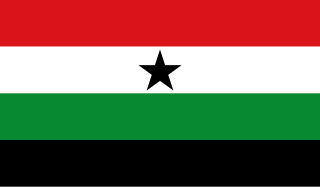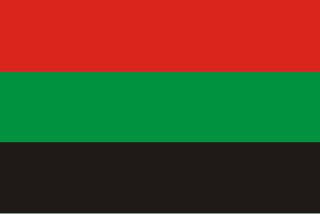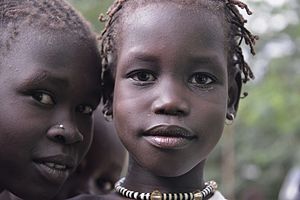
The Luo are several ethnically and linguistically related Nilotic ethnic groups that inhabit an area ranging from Egypt and Sudan to South Sudan and Ethiopia, through Northern Uganda and eastern Congo (DRC), into western Kenya, and the Mara Region of Tanzania. Their Luo languages belong to the western branch of the Nilotic language family.

The Nuer people are a Nilotic ethnic group concentrated in the Greater Upper Nile region of South Sudan. They also live in the Ethiopian region of Gambella. The Nuer speak the Nuer language, which belongs to the Nilotic language family. They are the second-largest ethnic group in South Sudan and the largest ethnic group in Gambella, Ethiopia. The Nuer people are pastoralists who herd cattle for a living. Their cattle serve as companions and define their lifestyle. The Nuer call themselves "Naath".

The Gambela Region (also spelled Gambella (Catching the male Leopard in Anywaa language); Amharic: ጋምቤላ), officially the Gambela Peoples' Region, is a regional state in western Ethiopia, bordering South Sudan. Previously known as Region 12, its capital is Gambela located in Anywaa zone. The Region is situated between the Baro and Akobo Rivers, with its western part including the Openo River. Covering an area of approximately 29,783 square kilometers, Gambela is one of Ethiopia's smaller regions and one of its least populous, with 525,000 inhabitants. It is home to a diverse population, including the Anuak the indigenous, Nuer, and other indigenous groups called Majang Komo and Opo. The region's economy is largely based on agriculture, with significant contributions from fishing and cross-border trade. The landscape is characterized by lowland plains, wetlands, and a tropical climate, making it distinct from the highland areas that dominate much of Ethiopia.
The Western Nilotic languages are one of the three primary branches of the Nilotic languages, along with the Eastern Nilotic languages and Southern Nilotic languages; Themselves belonging to the Eastern Sudanic subfamily of Nilo-Saharan. The about 22 Western Nilotic languages are spoken in an area ranging from southwestern Ethiopia and South Sudan via northeastern Democratic Republic of the Congo and northern Uganda to southwestern Kenya.

Gambela, also spelled Gambella, is a city and separate woreda in Ethiopia and the capital of the Gambela Region. Located in Anyuak Zone, at the confluence of the Baro River and its tributary the Jajjabe, the city has a latitude and longitude of 8°15′N34°35′E and an elevation of 526 meters. It is surrounded by Gambella Zuria.

The Shilluk are a major Luo Nilotic ethnic group that resides in the northeastern Upper Nile state of South Sudan on both banks of the Nile River in Malakal. Before the Second Sudanese Civil War, the Shilluk also lived in settlements on the northern bank of the Sobat River, close to where the Sobat joins the Nile.

The Gambela Peoples’ Democratic Movement, also known as the Gambela People’s Democratic Movement or Gambella Peoples’ Unity Democratic Movement, was a political party in the Gambela Region of Ethiopia. It was the regional ally of the ruling EPRDF coalition.
Itang is a woreda in Gambela Region, Ethiopia. Because Itang is not part of any zone in the Gambela Region, it is considered a Special woreda, an administrative subdivision which is similar to an autonomous area. It is bordered on the south and southeast by the Anuak Zone, on the west by the Nuer Zone, on the northwest by South Sudan, and on the north by the Oromia Region; part of the southern boundary is defined by the Alwero River. The major town in Itang is Itang.
Gambela Zuria was a woreda in the Gambela Region of Ethiopia. Part of the Anuak Zone, Gambela Zuria is bordered on the south by Abobo, on the west by Itang special woreda, and on the north and east by the Oromia Region. Gambela, which is the capital of the Region, is surrounded by this woreda.
Akobo (Aköbä) is a woreda in Gambela Region, Ethiopia. It is named after the Akobo in Anyuak language language, which translates as, and the Akoba River which flows westwards then north into the Baro River, defining its border with South Sudan. Part of the Nuer Zone, Akobo is bordered on the south and west by South Sudan, on the north by Wanthoa or Wanthɔa̱r, and on the east by the Anuak Zone. The westernmost point of this woreda is the westernmost point of Ethiopia. Towns in Akobo include Tergol.
'Jikaw (Ji̱ekɔ̱w) is a woreda in Gambela Region, Ethiopia. Part of the Nuer Zone, Jikaw is bordered on the south by the Anuak Zone, on the west by the Alwero River which separates it from Wanthoa, on the north by the Baro River which separates it from South Sudan, and on the east by Lare. Towns in Jikaw include Kuachthiang and Teluth.

The Gambela conflict refers to sporadic conflicts in the Gambela Region of Ethiopia between armed groups of the indigenous Anuak people with civilians of the indigenous Nuer people, and the Ethiopian military. Following resettlement policies implemented by the Derg regime in the 1980s, a number of ethnic conflicts have taken place between the Anuak people indigenous to much of the Gambela region, and other groups which were resettled in the region. Following the collapse of the Derg regime, persistent ethnic tensions in the region have occasionally exploded into open conflict. Such conflict erupted in the early to mid 2000s, coinciding with an increase in petroleum extraction in the region, and led to a number of incidents resulting in the large-scale deaths of civilians. The Ethiopian military has intervened to combat Anuak militias.
Agwa Alemo was an Ethiopian politician. He belonged to the Anyuak ethnic group, and became the first president of the Gambela Region.

The Gambela People's Liberation Movement was a rebel group in the Gambela Region in Ethiopia. The GPLM was founded by Anuak dissidents during the Derg and Woyane regime. The organization remained dominated by Anuaks. Agwa Alemu was the chairman of the GPLM.
Pochalla is a county in the Greater Pibor Administrative Area, South Sudan. The capital of the state, where the governor and state parliament is located, is in Bor town, which is situated on the Nile River at the western end of the state. Pochalla is to the extreme east of the state, located on the border with Ethiopia. Much of the County is sandwiched between two rivers, the Akobo, which forms the national boundary to the east, and the Oboth to the west. The dominant people group are the Anyuak who border the Murle to the west and the Nuer to the North, both of whom are cattle keeping tribes, who have a culture of raiding to increase their cattle numbers. To the east in Ethiopia, the Anuak have had tensions with the government, so communications are weak.

The Nuer Zone Amharic Thok Naath, is a zone in the Gambela Region of Ethiopia. It was created from former Administrative Zone 3. The Nuer zone is located in western Gambella and is the westernmost zone of Ethiopia. The Zone is bordered by South Sudan, on the Northern Baro River, Western Piwbör, and Southwestern Pibor River, on the east by Itang Special Woreda, and on the South-East by Anuak Zone. The administration town Nyinenyang, contains five administrator woreda; Kuergeng Town, Kuach Thia̱ng Town, Nyinenyang Town, (Wanthɔa̱r)Matar Town, and (Aköbä)Tiergol Town. Nuer Zone is within the Ethiopian lowlands and is relatively flat at an elevation between 400–430 meters above sea level. The zone consists of grasslands, marshes and swamps with some forests. The economy is predominantly based on livestock. In 2006, there were no agricultural cooperatives, no documented roads, and little other Reference infrastructure. Both Jikawo and Akobo woredas are flooded during the rainy season, requiring the people to migrate to the highlands with their cattle until the waters recede; thus raising livestock is the primary source of income in this Zone.
The Gambela People's Democratic Unity Party was a political party in Gambela Region, Ethiopia. GPDUP was mainly based amongst Nuer people, formed in 1992 in Nasir in the midst of mass displacements of Nuers as the Anuak-dominated Gambela People's Liberation Movement had taken control over Gambela in 1991. GPLM and GPDUP struggled violently against each other for most of the 1990s, until the Addis Ababa government intervened and forced the merger of the two parties into the Gambela People's Democratic Front in 1998.

The Ethiopian Unity Patriots Front is a political party and militant rebel organization that waged an insurgency against the Ethiopian government from 1993 to 2012. Formed by ex-officials of the Derg regime, the EUPF was mostly active in Ethiopia's Gambela Region as well as eastern Sudan and South Sudan. The group agreed to a ceasefire with the Ethiopian government in 2012, and officially ended its insurgency in 2016. The EUPF remains active, however, and its armed wing has reportedly been involved in the South Sudanese Civil War, although to what extent is disputed.
The Gambela Massacre was a three-day-long massacre in the city of Gambela targeting Anuak people in December of 2003. The massacre perpetrated by the ENDF and "highlander" militias after an ambush of ARRA employees. Calls from International community made to condemn and stop the various forms of attacks against the Anuak people- i.e. Ethiopia to take immediate action and to comply to the International Convention on the Elimination of All Forms of Racial Discrimination (“ICERD”). The calls included actions against: 1) Racial Discrimination, 2) State obligation to protect and ensure economic development, economic, social, and cultural rights, 3) Freedom of movement, 4)The right to equal treatment in the justice system, 5) Protection Against Violence, and 6) Access to Remedies and Justice for Crimes of Racial Discrimination.












